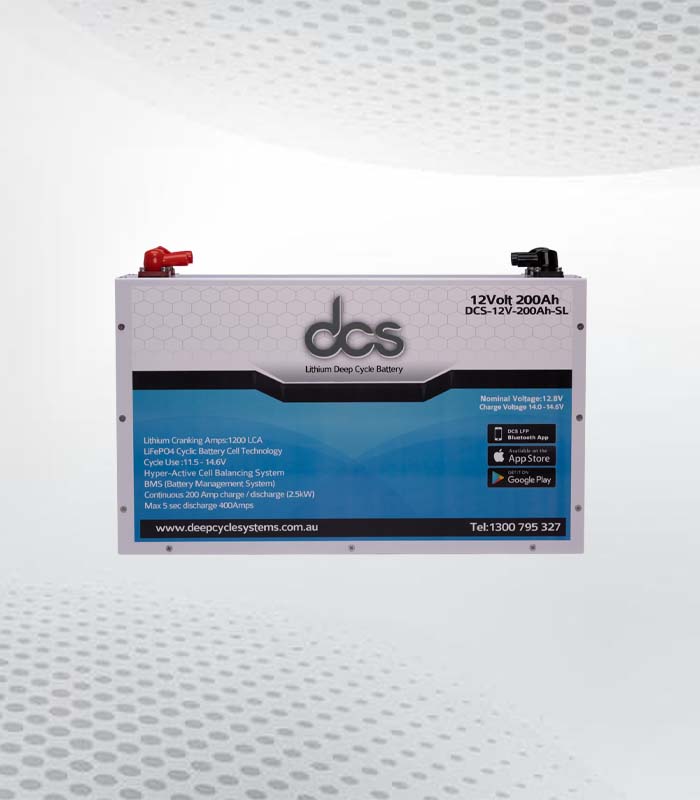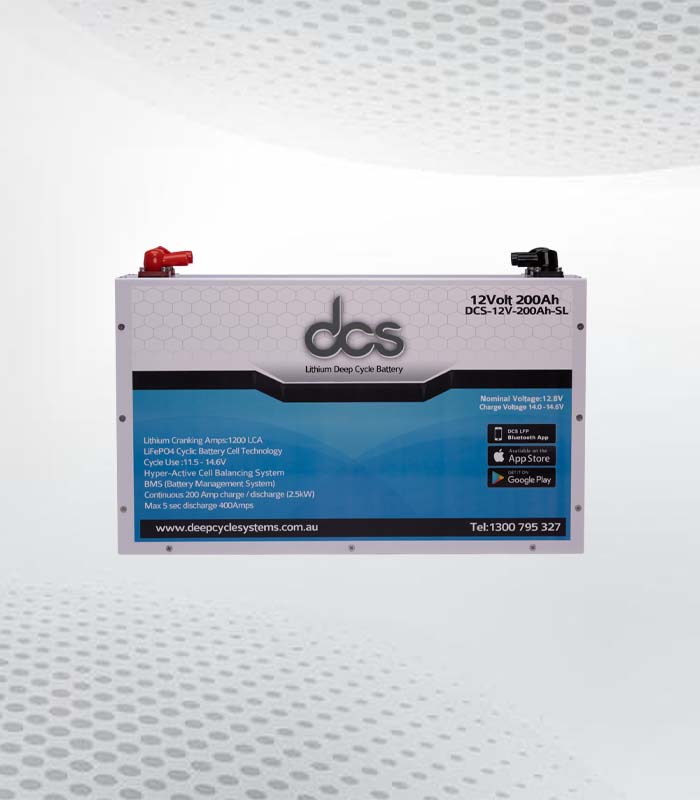The world is moving towards sustainable energy, and LiFePO4 deep-cycle batteries are at the forefront of this movement. These batteries are designed to power various devices, from electric vehicles to solar-powered homes. However, like all batteries, LiFePO4 deep-cycle batteries have a limited lifespan. The good news is that with proper care and maintenance, you can extend the life of your battery and get the most out of your investment. In this blog post, we will share some tips and tricks to help you maximize the lifespan of your Deep Cycle Battery. From proper charging and discharging techniques to storage and maintenance, we’ll show you how to get the most out of your batteries and unlock their full potential.
Introduction: Understanding LiFePO4 Deep Cycle Batteries
LiFePO4 deep cycle batteries are cutting-edge technology revolutionizing energy storage solutions. These batteries are known for their high energy density, longer lifespan, and exceptional performance in demanding applications. Understanding the fundamentals of LiFePO4 batteries is crucial for maximizing their potential and getting the most out of your investment.
Unlike traditional lead-acid batteries, LiFePO4 batteries use lithium iron phosphate as the cathode material, which offers several advantages, such as higher energy efficiency, faster charging capabilities, and improved safety features. These batteries are designed for deep-cycle applications, making them ideal for solar energy storage, electric vehicles, marine applications, and off-grid power systems.
In this comprehensive guide, we will delve into the intricacies of LiFePO4 deep cycle batteries, exploring their unique characteristics, maintenance requirements, charging protocols, and best practices for extending their lifespan. By thoroughly understanding these advanced energy storage solutions, you will be equipped to harness their full potential and unlock a world of possibilities for your energy storage needs.
Benefits of LiFePO4 Deep Cycle Batteries
LiFePO4 deep cycle batteries have revolutionized the world of energy storage with their impressive benefits. One of the key advantages of LiFePO4 batteries is their exceptional longevity. Unlike traditional lead-acid batteries, LiFePO4 batteries can endure a significantly higher charge cycle, making them a cost-effective and sustainable choice for long-term energy storage solutions.
Moreover, LiFePO4 batteries boast a high energy density, providing more power in a compact and lightweight design. This makes them ideal for limited space applications, such as in marine vessels, RVs, and solar energy systems. Also, LiFePO4 batteries are known for their superior safety features, with a much lower risk of thermal runaway or fire than other battery types.
Another benefit of LiFePO4 deep cycle batteries is their excellent performance in extreme temperatures. LiFePO4 batteries maintain their efficiency and reliability in scorching heat or cold, ensuring consistent power output in any environment. This durability and resilience make them popular for off-grid applications and mobile power solutions.
 Factors Affecting the Lifespan of Lifepo4 Battery
Factors Affecting the Lifespan of Lifepo4 Battery
The lifespan of Lifepo4 Battery is influenced by various crucial factors for maximizing their potential. One of the key determinants is the depth of discharge (DoD). LiFePO4 batteries have a longer lifespan when operated within a certain DoD range, typically around 80%. Operating the battery consistently at high DoD levels can significantly reduce its lifespan.
Temperature also plays a critical role in battery longevity. LiFePO4 batteries perform optimally at moderate temperatures, and exposure to extreme heat or cold can degrade the battery cells over time. Maintaining the batteries within the recommended temperature range is essential to ensure longevity and performance.
Furthermore, charging and discharging rates impact the lifespan of LiFePO4 batteries. Fast charging or discharging rates can generate excess heat and stress the battery cells, leading to premature degradation. Following the manufacturer’s guidelines regarding charging rates is advisable to extend the battery’s lifespan.
Maintaining Optimal Temperature Conditions for LiFePO4 Batteries
Maintaining optimal temperature conditions for LiFePO4 batteries is crucial in maximizing their lifespan and performance. These batteries operate best within a specific temperature range, typically between 0°C and 45°C (32°F to 113°F). Extreme temperatures can significantly impact the overall efficiency and longevity of the batteries.
To ensure that your LiFePO4 batteries operate within the ideal temperature range, storing them in a controlled environment is essential. Avoid exposing the batteries to direct sunlight, heat sources, or freezing conditions. If using the batteries in harsh environments, consider implementing temperature regulation systems or insulation to protect them from temperature extremes.
Regular monitoring of the temperature of your LiFePO4 batteries is also recommended. Utilize temperature sensors or monitoring devices to ensure the batteries operate within the optimal range. By maintaining proper temperature conditions, you can prolong the lifespan of your LiFePO4 batteries and optimize their performance for long-term use.
Implementing Depth of Discharge (DoD) Strategies
Implementing Depth of Discharge (DoD) strategies is crucial in maximizing the lifespan and performance of LiFePO4 deep cycle batteries. Depth of Discharge refers to the percentage of a battery’s capacity used during a discharge cycle. LiFePO4 batteries have a recommended Depth of Discharge that, if followed, can significantly extend their lifespan.
One effective DoD strategy is to avoid deep discharges whenever possible. Deep discharging a LiFePO4 battery below its recommended Depth of Discharge can lead to irreversible damage and shorten its lifespan. By implementing a strategy to keep the Depth of Discharge within the recommended range, you can ensure your battery lasts longer and performs optimally.
Another important DoD strategy is to balance the Depth of Discharge across multiple batteries in a system. If batteries within a system experience varying Depths of Discharge, some batteries may degrade faster than others, leading to imbalances in performance and capacity. By monitoring and managing the Depth of Discharge for each battery in the system, you can maintain consistency and prolong the lifespan of the entire battery bank.
Avoiding Overcharging and Over discharging LiFePO4 Batteries
Overcharging and over discharging are two common culprits that can significantly impact the lifespan and performance of LiFePO4 deep-cycle batteries. To ensure that you are maximizing these batteries’ potential, avoiding these damaging practices is crucial.
Overcharging a LiFePO4 battery can lead to excessive heat generation, which can cause internal damage and reduce the battery’s overall lifespan. It is essential to use a compatible charger with a proper voltage and current rating to avoid overcharging. Investing in a smart charger that automatically stops charging once the battery reaches full capacity can help prevent overcharging and protect the battery from unnecessary stress.
Similarly, over discharging a LiFePO4 battery below its recommended minimum voltage can also be detrimental. This can lead to irreversible damage, decreased capacity, and potentially render the battery unusable. To avoid over discharging, monitoring the battery’s voltage levels regularly and ensuring that it is not drained beyond the specified limits is essential. A battery management system (BMS) can help prevent over discharging by providing protection mechanisms and ensuring safe operation.
Importance of Regular Maintenance and Monitoring
Regular maintenance and monitoring are crucial aspects of maximizing the lifespan of LiFePO4 deep-cycle batteries. Like any other valuable equipment, these batteries require proper care to ensure optimal performance and longevity.
One of the key maintenance tasks is to regularly inspect the batteries for any signs of wear and tear, corrosion, or damage. This can help identify potential issues early on and prevent them from escalating into more serious problems. Cleaning the batteries and terminals regularly helps prevent corrosion and ensure good electrical conductivity.
Monitoring the batteries’ performance is equally important. Keeping track of important metrics such as voltage levels, charging and discharging currents, and overall capacity can provide valuable insights into the health of the batteries. Monitoring these parameters regularly allows you to identify deviations from normal behaviour and take corrective actions if needed.
Recycling and Disposal of LiFePO4 Batteries
When it comes to the end of a LiFePO4 battery’s lifespan, it’s crucial to properly handle its recycling and disposal. These batteries contain valuable materials that can harm the environment if not managed correctly. The recycling process for LiFePO4 batteries involves extracting valuable metals such as lithium, iron, and phosphorus, which can be repurposed for future use.
Proper disposal of LiFePO4 batteries is essential to prevent environmental contamination. These batteries should never be thrown in regular trash bins as they can leak toxic chemicals into the soil and water supply. Instead, they should be taken to designated recycling centres or hazardous waste disposal facilities.
By responsibly recycling and disposing of LiFePO4 batteries, we can reduce our environmental impact and contribute to a more sustainable future. Remember, every small effort counts towards preserving our planet for future generations.
Tips for Maximizing the Lifespan of LiFePO4 Deep Cycle Batteries
In conclusion, maximizing the lifespan of LiFePO4 deep-cycle batteries is crucial for ensuring optimal performance and longevity. By following the tips mentioned in this article, you can significantly extend the lifespan of your batteries and get the most out of your investment.
Always use a compatible charger for LiFePO4 batteries to avoid overcharging and damaging the cells. Properly maintaining the battery by keeping it at the recommended state of charge and avoiding deep discharges will also help prolong its lifespan.
Additionally, storing the batteries in a cool and dry environment when not in use can prevent degradation and maintain their capacity over time. Regularly checking the battery for signs of wear and tear and promptly replacing any damaged components will also contribute to maximizing its lifespan.
FAQs
What steps can I take to prolong the lifespan of my deep cycle battery?
To maximize the lifespan of your deep cycle battery, it’s essential to follow proper charging and maintenance practices. Avoid deep discharges whenever possible and recharge the battery promptly after use. Keep the battery clean and free of corrosion, and store it in a cool, dry location when not in use. Regularly inspect the battery terminals and connections for signs of damage or corrosion, and replace any worn components as needed. Additionally, follow the manufacturer’s recommendations for charging voltage and current to prevent overcharging and thermal stress.
How does proper charging affect the lifespan of a deep cycle battery?
Proper charging is crucial for extending the lifespan of a deep cycle battery. Overcharging or undercharging can lead to premature degradation and reduced capacity over time. To maximize battery lifespan, use a charger specifically designed for deep cycle batteries and follow the manufacturer’s recommended charging parameters. Avoid fast charging methods that exceed the battery’s rated voltage and current, as these can cause overheating and damage the battery cells. Additionally, consider implementing a smart charging system with built-in voltage regulation and temperature sensing to optimize charging efficiency and battery health.
Are there any specific maintenance tasks I should perform regularly to ensure the longevity of my deep cycle battery?
Yes, regular maintenance is essential for preserving the lifespan of a deep cycle battery. Periodically inspect the battery terminals and cables for signs of corrosion or loose connections, and clean them with a mixture of baking soda and water if necessary. Check the electrolyte levels in flooded lead-acid batteries and top them up with distilled water as needed. For sealed lead-acid or AGM batteries, ensure proper ventilation and avoid overcharging to prevent gas buildup.
Conclusion
In conclusion, we have delved into the world of LiFePO4 deep-cycle batteries and explored the various ways to maximize their lifespan. By understanding the key factors that influence battery longevity and implementing proper maintenance techniques, you can unlock the full potential of these powerful energy storage solutions. Remember, taking care of your batteries extends their lifespan and ensures optimal performance for all your energy storage needs. Here’s to harnessing the power of LiFePO4 batteries for years to come!
| Other Good Articles to Read |
| Skank Blogs |
| Unreal Blogs |
| Tba Blogs |
| All City Forums |
| Dany Blogs |
| Refuge Blogs |
| The Music Blogs |
| Key Forums |
| The Big Blog Theory |
| Joe Blogs |
| Blogs 4 Me |
| Blogs Emon |
| Related Business Listings |
| Contact Directory |
| Local Business Profiles |



